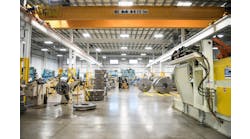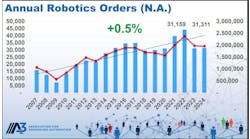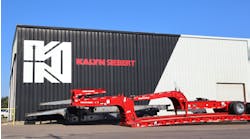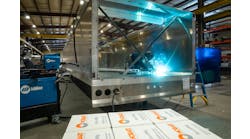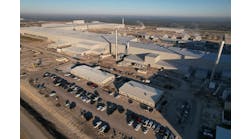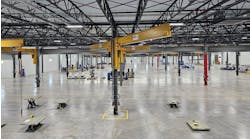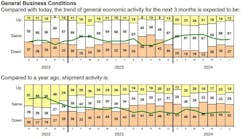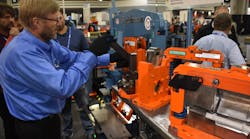ATLANTA, GA. American manufacturing is back—big time. Automation, the supply chain revolution, and a C-suite refocus on long-term planning bode well for this industrial renaissance, a panel at FABTECH explained here this week. But trade wars and a shortage of workers will likely lead to inflation and a recession—a downturn that might only be an economic hiccup, or might not.
The challenges are significant, and so are the rewards: Re-sourcing China supply, or at least reestablishing global trade norms, is a must. Domestically, manufacturers must show policymakers and educators that jobs, good jobs—careers for the 21st century—are already available for the taking; what industry needs is Americans with new and appropriate skills.
“Manufacturing is clearly hot, hot, hot,” said Rosemary Coates, executive director of the Reshoring Institute, a non-profit organization that partners with universities to help companies reestablish manufacturing operations in the US. “But this is not your grandfather’s manufacturing. This looks different than it looked 40 or 50 years ago.”
For complete coverage FABTECH 2018, see the December print issue of Trailer/Body BUILDERS.
The “watershed moment” occurred in the late 1990s when industry “woke up” and embraced the advantages of automation technology and robotics, explained Chris Kuehl, managing director at Armada Corporate Intelligence, who also serves as the economist for the Fabricators and Manufacturers Association.
“We all remember when manufacturing seemed to be on its last legs,” he said. “In the 1980s we almost had given up: The mantra was the US is in a ‘post-industrial age’ and we’d never be a manufacturing state again. We’d be relying on services and financial products. And, at that point, manufacturing was overwhelmingly labor. We couldn’t compete with the Chinas and the Indias and the Mexicos. Then along came the computer revolution.”
And even as some 20 million manufacturing jobs were lost, automation and robotics made the US competitive again, Kuehl continued.
“What we’ve been experiencing since is just a transition,” he said. “But what do we look like going into the future?”
Or, as Coates characterized the ebb and flow of US jobs: “out like a tsunami, in like raindrops.”
Training
As Coates noted, modern manufacturers don’t need minimum wage assembly workers—instead they need people who can “run the robot” that’s doing the assembly.
Indeed, one of the “great challenges for society” is managing this transition to smarter workers, Kuehl explained.
“What do you do for entry-level jobs going forward?” he said, and he recalled the traditional “work your way up” career path for people in manufacturing, and the stable middle-class living that could be earned. Currently, technical skills are required to work on the factory floor and the only unskilled work is limited to retail and service jobs, with little opportunity for growth and advancement.
“It’s a double whammy,” Kuehl said. “We’re looking for people that are hard to find. We are struggling to find training opportunities to get people where they need to be.”
Added Coats: “Manufacturing has evolved. We need ‘new-collar’ workers. There are a lot of jobs that are crossovers between engineering and assembly that require a higher level of training and thoughtfulness. They have to run computers and know geometry and fix robots.”
Solving the problem is a matter of time and money.
“It’s not like we could start training tomorrow and generate 50,000 ready-made workers,” Kuehl said. “We’re talking about getting to kids in middle school and high school and convincing them that manufacturing is a legitimate way to make a living—then it takes time to matriculate through the system. We’ve neglected the pipeline, so the pipeline isn’t there.”
Currently, manufacturers are hiring with the “expectation” that it will take 24-36 months to get a worker up to speed, he noted.
Coates considered the challenge from a “personal” level. Even with her career in manufacturing and consulting, she never talked to her own children about jobs in industry. More broadly, the trend in higher education has moved away from operations, focusing instead on finance and marketing.
“Each of us has to make a commitment to talk about manufacturing,” she said, and used the example of a baseball-loving grandson and Louisville Slugger bats. “Make that connection [to their interests] personal, so they understand manufacturing is a potential career, whether you’re on the assembly line, or an engineer, or an MBA.”
Kuehl likewise called on people in industry to “demystify” manufacturing, explaining that the average American will drive past a plant without giving a second thought to what it makes, or that the goods they take for granted have to be made somewhere by someone.
And, as a former academic, he agreed that universities too often teach students business strategy, or “how to be CEOs,” and he joked that most companies aren’t likely to hire a 19-year-old to step into the top job.
The good news, Coates suggested, is that community colleges “have stepped up” to fill the role of trade schools—but manufacturers still need highly trained workers in engineering and logistics.
Similarly, companies need to better educate rising operations personnel on business aspects such as cashflow and marketing.
“You have this huge division between the operators, who are the lifeblood of your company, yet they don’t know what it takes to run it,” Koehl said.
Public policy
There’s also a huge division between what policy makers want and what companies need. Politicians love to talk about creating jobs, but they seem to be unaware that industry can’t fill the jobs it has, Coates and Kuehl agreed.
“They’re trying to solve the wrong problem,” Coates said.
In Iowa, the industrial development agency is actually telling businesses not to relocate because workers aren’t available, Kuehl noted. And FoxConn, according to reports, has plans to bring in workers from China to fill jobs at its heavily subsidized Wisconsin facility.
The lesson, suggested Kuehl, is that manufacturers shouldn’t count on the government for leadership.
“We have to lead them,” he said.
In the same way people in industry need to spread the word among friends and family, manufacturers need to take the message to politicians, regulators, government officials, and educators.
“We need to get good at going to these institutions and saying, ‘You need to be doing something for me—I’m trying to help you. I am trying to build this community. I am a reason this community exists,’” Kuehl said. “When it comes right down to it, it’s the state and local guys that really have a stake in your success. You have start pushing back.”
Trade trends
At the federal level, industry has benefitted from recent tax reform and a relaxed regulatory environment, but tariffs are causing “chaos,” Coates suggested.
As a consultant, she works with manufacturers to identify their leading material needs and find alternative sources to China, where the escalating trade war is most severe. The problem, she noted, is that US sources for steel and aluminum are “overbooked,” leading to significant backlogs and price increases.
And, with another tariff increase taking effect in January 2019, many companies are “hoarding” inventory—and that’s making the shortages worse, she suggested.
“Some companies are passing those costs on to customers; some are absorbing those costs; some are trying to split the costs,” Coates said. “And they’re trying desperately to source products in the US if they can, and if they’re competitively priced.”
Similarly, US-based manufacturers with production operations in China are looking for low-cost alternatives, such as Thailand or Viet Nam, rather than bringing those operations back to the US.
The issue is that China doesn’t “play by the same rules,” noted Kuehl—and never has.
“They’ve been a thorn in the side of the US for years. Countries all over the world are trying to figure out how to balance what they do with China,” he said. “It’s a very appealing market, but it’s very frustrating.”
The tariff implementation process has been “very stop and go,” he added, referring to the widespread exemptions for many other countries—just not China.
“The biggest challenge right now is to figure out who’s got the biggest stake in this trade war, and who has the most leverage,” Kuehl said. “It’s going to be hard on everybody to begin with but, down the road—maybe years and years—China’s challenge is finding a replacement consumer: a country or countries that will buy as much as we do. Good luck with that.”
The flip side is that the insatiable US consumer market will have to find other sources. He noted specifically the push from India, where the goods a price-competitive to make but the logistics costs have been much higher.
Indeed, Kuehl anticipates many countries that formerly had a substantial presence in the US market—but who lost share to China’s production and logistical efficiencies—will return.
“Eventually, the world will figure out a new play. [The US] has a less serious challenge in some respects than China,” he said. “We have to find sources; they have to find customers. But there’s no place in the world you can find customers like ours.”
Looking ahead
Asked by panel moderator Ben Harris of the Metro Atlanta Chamber for a 5 to 10-year outlook, Kuehl pointed to the demographic transition as baby boomers age out of the workforce—but the incoming Gen Z workforce, noted for a high level of seriousness and ambition, “may be best, most recruitable population we’ve had in a while.”
Advances in additive technology will mean much wider adoption in manufacturing, he also noted, and a “much more integrated world” will allow even small businesses can be involved in the global supply network.
“The supply chain revolution is really taking place,” Kuehl said. “The advances in terms of tracking goods and understanding total landed costs are worlds away from what they were just 10 years ago.”
Finally, he pointed to “the rhythm of the economy,” and suggested the current period of sustained growth will come to an end. The question, however, is whether the downturn will be “a short and sharp one” that shakes out poorly run companies, or “another grinding long slog” like 2008-2009. Inflation and rising interest rates are also business pressures that have been absent during the recovery—but that’s coming to an end.
Coates reported seeing a “progression of strategic decision making,” in which executives are more willing to think long term.
“I’ve been in management consulting for a long time, and I used to help plants decide if they should move to China—and it wasn’t much of an analytical process,” she said. “I see a different trend now where senior executives base their decisions on facts. They’re looking at data analytics to determine where they’re customers are, where the growth is likely to be, what kind of products they should have.”
As an example, Coates cited GE which, after shifting much of its manufacturing to China, decided to locate plants that produce high-end appliances in the US to be near the customer base—creating thousands of jobs in the process.
“That’s the kind of success story we see when companies think through the economics, considering a high-level strategy and having the data to support it. How can they engineer a process to be more efficient to support it? Those all go together,” she said. “It’s a much more complex approach than, ‘I’ve never been to China, so let’s go.’”
What about today?
But, as it became apparent when the floor was opened for questions, manufacturers in the audience were looking for immediate answers to the labor shortage.
Koehl had a very direct solution.
“The practical advice is not something that I would want to give, but it’s realistic: poach. You may have to hire other people’s people. And right now, that’s what a lot of people are doing,” he said—but he immediately qualified that answer. “Unfortunately, that’s inflationary—and a great way to make enemies.”
He also suggested finding skilled talent abroad and bringing in workers, and working with the armed services through government/industry transition programs.
For Coates, it’s again a strategic issue.
“We have to step up and think about employee skills and how you’re going to move forward,” she said. “That may be partnering with HR departments, cross training people, or working with a local community college more effectively. You’ve got to add that dimension to your work life if you’re going to survive in the long term.”
